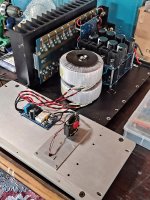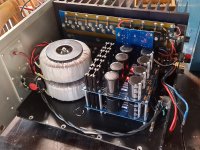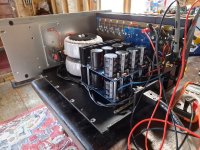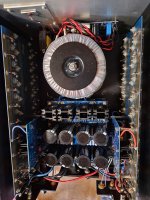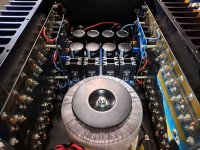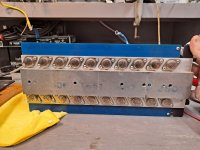Thank you, that's very kind.Hadley, you perfectly illustrate the proverb "Value does not wait for the number of years"
You have done a remarkable job with patience and mastery, my respect.
Yes, the former owner clearly loved the amp given how much he likely spent just on resistors. Or were metal foil resistors not so expensive once upon a time? I purchased this amplifier (S/300 II) from someone who was liquidating the former owner's gear. This was not even a month before I lucked into the whole NOS set which this thread is mostly about. I'm glad I had this amplifier to practice on. The previous owner left it on 24-7-365 so it certainly did need a few things, but I didn't go nuts on this one like I did the SA-1s.I had not seen on first reading but these (or this) amp had a life before
View attachment 1079868
Very elaborate and thorough job! Wish I had those skills to perform this type of service.I have one of the SA-1s back together.
What was done:
-Completely disassembled heatsinks and removed all transistors to clean and apply new thermal paste. Replaced numerous mica insulators. It took ~50 grams of paste to do the job.
-Replaced all four filter capacitors.
-Replaced all emitter resistors.
-Replaced tantalum capacitor and 10uf polyester cap on driver board with polypropylene units. The 10uf fit fine.
-Replaced the 2N5566 with a IFN5564.
The old thermal paste needs to be replaced if you have one of these amplifiers. On my unused unit, much of it had run down the side of the heatsinks and pooled near the bottom of the chassis. I found numerous areas that had essentially no coverage. This means that your heatsinks won't properly warm up and as a result your bank of transistors could be too hot. Yes, there is certainly a margin for error here, but given the cost of these amplifiers, I don't want my heatsinks at different temperatures and I wouldn't have in 1989 if I had bought them then. The second picture is how it does and should look.
The amplifier sounds good, but I will A/B against the still original unit and report back my findings. Power consumption after service is much lower but I will likely need to set the bias. Certainly a good sign though that the unit isn't consuming 500+ watts at power on. I'll also measure the DC at the outputs.
Just acquired a couple of SA1's, also black ones, from the first owner. They are certainly not looking so good as yours, but they probably are Threshold finest aesthetically for sure (graphic designer Rene Besne) and some state it was the pinnacle design from Threshold by NP of course.
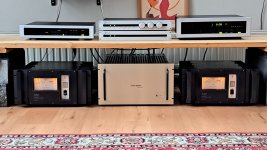
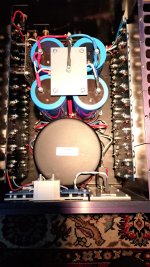
I bought them from a former tech of the German importer WBS and he stated the eight 29,000 uF Mallory CGS large cans are still okay. I'm aware that not using the amps is more harmful to the caps than regular use (shelf life). The tech also stated and stressed twice that I should install a DC speakerprotection circuit because of the age (the black are from 1988, derived from the datecode of the Mallory caps) of the amps. He did this on a SA/4:
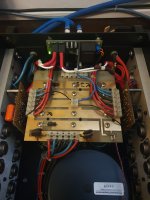
This one operates with a relay but I found another one that operates with MOSFET's to cut the output when sensing too much DC that could potentially harm your loudspeakers. It's a Guardian-86 from https://neurochrome.com/products/guardian-86.
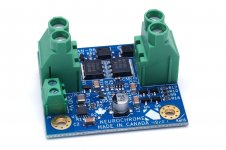
I hope somebody can shed some wisdom on this matter and I must admit that I never had any failure of this kind before with Pass or Threshold amplifiers and I did never ever saw them at high-end audio repairfacilities.
I wonder if I should have my 12e's looked at. Don't know of anyone locally and shipping is prohibitive.
Anyone in South Florida?
Anyone in South Florida?
So I know this is an old thread. However, I had a couple of thoughts:
-In regards to listening tests, you may have to give them a couple of weeks or so to come back if you haven't. Also, let your ears burn in to their sound as well. Nothing has been broken in on that amp and it hasn't been turned on since 1988. It should theoretically sound smoother and nicer than your S/300. But maybe you have done this and the amps sound is not to your taste.
-Below is a chart specifying the bias voltage. You should have around 90-110 or so mv across one of your 1 ohm resistors. I think I read you had between 50mv-65mv. Set the bias so that the temperature is about 25 degrees celsius above ambient and see if it gets to the spec in the chart below.
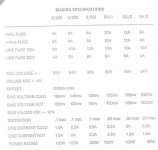
-I believe seeing a higher power consumption when cold versus hot is normal.
-I did a lot of work to a S/500 and noticed shoulder bolts holding the heatsinks on. So in other words, the heatsinks are not tight to the heat spreader rail. I believe this is to allow for a little thermal expansion. I did the same as you and added thermal grease between the heatsinks and the rails. I purchase the Arctic Silver stuff in large sizes which is actually not as expensive as you would think.
https://www.amazon.com/gp/product/B07LDK4F5R/ref=ppx_yo_dt_b_search_asin_title?ie=UTF8&psc=1
I believe the signal ground is tied to the chassis. You can lift these if you would like. Also, adding a snubber circuit to the transformer made a very big difference in the highs/mids for me. The snubber circuit would be my next step if I were you.
The power supplies are pretty simple on these. No filtering at all. Just a large-cap bank. You can measure the ripple if you like. I replaced mine with the DIYaudio universal PS boards which helped quite a bit. But then I changed quite a few other things as well.
Usually, when checking an amp over like this, I check the voltage drop across each of the emitter resistors to see if they are within 10% or so, check the DC offset, and check the rail voltage. Then I hook up my favorite pair of speakers because I am a thrill seeker.
-In regards to listening tests, you may have to give them a couple of weeks or so to come back if you haven't. Also, let your ears burn in to their sound as well. Nothing has been broken in on that amp and it hasn't been turned on since 1988. It should theoretically sound smoother and nicer than your S/300. But maybe you have done this and the amps sound is not to your taste.
-Below is a chart specifying the bias voltage. You should have around 90-110 or so mv across one of your 1 ohm resistors. I think I read you had between 50mv-65mv. Set the bias so that the temperature is about 25 degrees celsius above ambient and see if it gets to the spec in the chart below.

-I believe seeing a higher power consumption when cold versus hot is normal.
-I did a lot of work to a S/500 and noticed shoulder bolts holding the heatsinks on. So in other words, the heatsinks are not tight to the heat spreader rail. I believe this is to allow for a little thermal expansion. I did the same as you and added thermal grease between the heatsinks and the rails. I purchase the Arctic Silver stuff in large sizes which is actually not as expensive as you would think.
https://www.amazon.com/gp/product/B07LDK4F5R/ref=ppx_yo_dt_b_search_asin_title?ie=UTF8&psc=1
I believe the signal ground is tied to the chassis. You can lift these if you would like. Also, adding a snubber circuit to the transformer made a very big difference in the highs/mids for me. The snubber circuit would be my next step if I were you.
The power supplies are pretty simple on these. No filtering at all. Just a large-cap bank. You can measure the ripple if you like. I replaced mine with the DIYaudio universal PS boards which helped quite a bit. But then I changed quite a few other things as well.
Usually, when checking an amp over like this, I check the voltage drop across each of the emitter resistors to see if they are within 10% or so, check the DC offset, and check the rail voltage. Then I hook up my favorite pair of speakers because I am a thrill seeker.
Hi Mike,
All the Thresholds amps do taper of their quiescent current when warming up like this:

Your S/500 and one of my SA/1 (same chassis psu and number of output devices) then settles down at 2.2 amps at a 120 Volt line.
I love to know the snubber values at your two bridge rectifiers (the two caps and the resistor) and maybe a picture of it when possible.
All the Thresholds amps do taper of their quiescent current when warming up like this:
Your S/500 and one of my SA/1 (same chassis psu and number of output devices) then settles down at 2.2 amps at a 120 Volt line.
I love to know the snubber values at your two bridge rectifiers (the two caps and the resistor) and maybe a picture of it when possible.
Yes, they are pretty much the same as you say. Even the same output devices. Your SA/1 has one front stage since it is one channel as opposed to mine which is stereo.
So mine is not stock by any means. It runs 39 volt rails instead of the stock 80 volt rails. So I guess you could say it is a SA/2.5...ish?
I am also running Mr Pass's new stasis front end which he put out in 2021. It works great. I talk more about the amp in the New Stasis Front End thread.
The snubber values are not for the stock transformers but for the lower voltage Anteks that I replaced it with. However, if you want some rectifier snubber boards, RhThatcher has them. You can see if he is willng to sell some. I think the SA/1 and the S/500 use different transformers anyways.
So mine is not stock by any means. It runs 39 volt rails instead of the stock 80 volt rails. So I guess you could say it is a SA/2.5...ish?
I am also running Mr Pass's new stasis front end which he put out in 2021. It works great. I talk more about the amp in the New Stasis Front End thread.
The snubber values are not for the stock transformers but for the lower voltage Anteks that I replaced it with. However, if you want some rectifier snubber boards, RhThatcher has them. You can see if he is willng to sell some. I think the SA/1 and the S/500 use different transformers anyways.
Attachments
Last edited:
Yes I know have had the S/1000 and S/500 also and they have two frontend boards indeed.Your SA/1 has one front stage since it is one channel as opposed to mine which is stereo.
It looks gargantuan and it is probably transformed into a big Class A amplifier I reckon.So mine is not stock by any means. It runs 39 volt rails instead of the stock 80 volt rails. So I guess you could say it is a SA/2.5...ish?
I'll ask him but the transformers VA rating is the same for the S/1000, SA/1 and S500 only the secondary voltages are different of course.The snubber values are not for the stock transformers but for the lower voltage Anteks that I replaced it with. However, if you want some rectifier snubber boards, RhThatcher has them. You can see if he is willng to sell some. I think the SA/1 and the S/500 use different transformers anyways
Yes it is about 70 to 80 watts of class A. Also because of the rail voltage it doesn't go into class B very much if at all which is fine by me because it sounds better than stock to my ears.
You can build a cheapo Modo (inexpensive version of the Quasimodo) for pretty cheap. About $30 or so. Then you'll need some sort of power supply like a 9 volt battery or a wall wart within the voltage range that it requires.
Last thing you'll need is and oscilloscope. The procedure is not very difficult. Reading the article that Mark Johnson wrote can be kind of confusing but the actual process of testing your transformer is pretty simple.
I believe the stock power transformer in the S500 is 2 secondaries each center tapped and each one going to a channel. So kind of dual mono but with one transformer. So I guess one question would be does your SA/1 have a single secondary center tap supply? You would need to know how the transformer works in order to test it appropriately as well as wiring in the snubber
You can build a cheapo Modo (inexpensive version of the Quasimodo) for pretty cheap. About $30 or so. Then you'll need some sort of power supply like a 9 volt battery or a wall wart within the voltage range that it requires.
Last thing you'll need is and oscilloscope. The procedure is not very difficult. Reading the article that Mark Johnson wrote can be kind of confusing but the actual process of testing your transformer is pretty simple.
I believe the stock power transformer in the S500 is 2 secondaries each center tapped and each one going to a channel. So kind of dual mono but with one transformer. So I guess one question would be does your SA/1 have a single secondary center tap supply? You would need to know how the transformer works in order to test it appropriately as well as wiring in the snubber
I know that has to done for optimal result. I was hoping there would be another user with a SA/1 already with a snubbercircuit in place and I could copy the data.
These amps finally are done.
Replaced all of the resistors and transistors on the first board on 5/6 and then on the second 5/7. I may have mentioned this earlier in the thread but I had previously purchased metal foil resistors (tx-2575 z-foil which is the low temperature coefficient vishay based metal foil spec) from Texas Components (or TCC as they're known) and while I don't recommend doing business with them, I would indeed use metal foil resistors again as they do make an obvious measured and sonic difference. As I did on my 400a, I replaced a resistor associated with the input differential pair with a potentiometer so that I could adjust the value and eliminate the dc offset that always exists with these amps otherwise. The good news is that in doing so, the turn-on thump Threshold owners all seem to deal with is greatly reduced. I am confident the DC offset has something to do with the thump because in the amplifier that I nulled, I noticed the thump was far less than the already reduced amount in the other amp. The only difference between the two amps is that one was nulled and the other has ~20mV DC at the outputs.
Sloppy work by my standards, but I was limited by the lack of care TCC showed in setting these resistors to the specified lead spacing (they were also rude, but another story for a different time).


Sound? These are in a completely different class now. The vagueness in the mids and highs is gone and I'm sitting here listening to music as I write this post.
Power consumption is even lower now while heatsink temperature has remained about the same. The pair of amps is now consuming ~340 watts combined with heatsinks at ~110 degrees. Not sure of the theoretical max efficiency of class A amplification but would not be surprised if I'm not quite at the correct bias, but I don't want these heating the room anymore than they already are until it's a bit cooler here.
Replaced all of the resistors and transistors on the first board on 5/6 and then on the second 5/7. I may have mentioned this earlier in the thread but I had previously purchased metal foil resistors (tx-2575 z-foil which is the low temperature coefficient vishay based metal foil spec) from Texas Components (or TCC as they're known) and while I don't recommend doing business with them, I would indeed use metal foil resistors again as they do make an obvious measured and sonic difference. As I did on my 400a, I replaced a resistor associated with the input differential pair with a potentiometer so that I could adjust the value and eliminate the dc offset that always exists with these amps otherwise. The good news is that in doing so, the turn-on thump Threshold owners all seem to deal with is greatly reduced. I am confident the DC offset has something to do with the thump because in the amplifier that I nulled, I noticed the thump was far less than the already reduced amount in the other amp. The only difference between the two amps is that one was nulled and the other has ~20mV DC at the outputs.
Sloppy work by my standards, but I was limited by the lack of care TCC showed in setting these resistors to the specified lead spacing (they were also rude, but another story for a different time).
Sound? These are in a completely different class now. The vagueness in the mids and highs is gone and I'm sitting here listening to music as I write this post.
Power consumption is even lower now while heatsink temperature has remained about the same. The pair of amps is now consuming ~340 watts combined with heatsinks at ~110 degrees. Not sure of the theoretical max efficiency of class A amplification but would not be surprised if I'm not quite at the correct bias, but I don't want these heating the room anymore than they already are until it's a bit cooler here.
If it ain't broke don't fix it!!
Check it thorough. Currents voltages offsets PSU ripples under the load. Caps may re-form to near original values when put under tension if not dried.
In regard to resistors: unless you have four wire ohm meter for low values the measurements of yours are, let's say, nor precise, not mentioning oxidation of terminals etc. Assuming welded construction no way a piece of wire will change 10 % in 30 years. The latter is a life span of an airplane; it does not become 10% longer or 10% thinner or does it?
I think my way worked out juuuuust fine.
I bet the amp sound as always, is you who is listening different. I don't confide in human ears like audio analyzers because they lies. Sorry, is my point of view.
If you are happy and you think it sounds better, it's ok.
If you are happy and you think it sounds better, it's ok.
Was your point of view really needed here when you haven't heard the amps and I have?I bet the amp sound as always, is you who is listening different. I don't confide in human ears like audio analyzers because they lies. Sorry, is my point of view.
If you are happy and you think it sounds better, it's ok.
The Hadley 622C is what I've used mainly for the last couple of years. I mention it earlier in the thread.very nice! What amps have you been able to compare your Threshold to?
Cool. Well, I am glad to see you enjoying your SA/1 monos! These old amp Stasis amps sound so pleasing. Not the most dynamic in the bass (compared to the newer X amps) and not the last word in detail but the sound is simple and warm.
I put my new front end together with Dale resistors. The original was a mixture of standard metal films and some Dales I believe.
Before I did the front-end work, I replaced the old CC emitter resistors with Dales. I was surprised as it did have an effect on the sound which caught me off guard.
If someone wanted to simply replace the thermal paste, you can remove one heatsink at a time. One bolt off of the top cover, one off of the bottom then the big hex head at the center of the heatsink. Clean the surface with isoprophyl alcohol and replace the thermal paste. Or you can just replace them all Attached is a picture.
I put my new front end together with Dale resistors. The original was a mixture of standard metal films and some Dales I believe.
Before I did the front-end work, I replaced the old CC emitter resistors with Dales. I was surprised as it did have an effect on the sound which caught me off guard.
If someone wanted to simply replace the thermal paste, you can remove one heatsink at a time. One bolt off of the top cover, one off of the bottom then the big hex head at the center of the heatsink. Clean the surface with isoprophyl alcohol and replace the thermal paste. Or you can just replace them all Attached is a picture.
Attachments
It's an amplifier, nothing else, like others.Was your point of view really needed here when you haven't heard the amps and I have?
I've seen a lot of bad amplifiers in Hi-End world, and their customers happy because they think they have the best.
The audiophile's says they can tell the difference between Hi-End amplifiers and low cost amplifiers, but, whey I test them in a double test, they fail. Is the human mind, with its ego, its fragile. I prefer electronic instrumentation, they don't feel, they just measure. Audiophile, audio analyzer is your friend.
Last edited:
- Home
- Amplifiers
- Solid State
- Brand New Threshold SA-1 Pair from 1988
